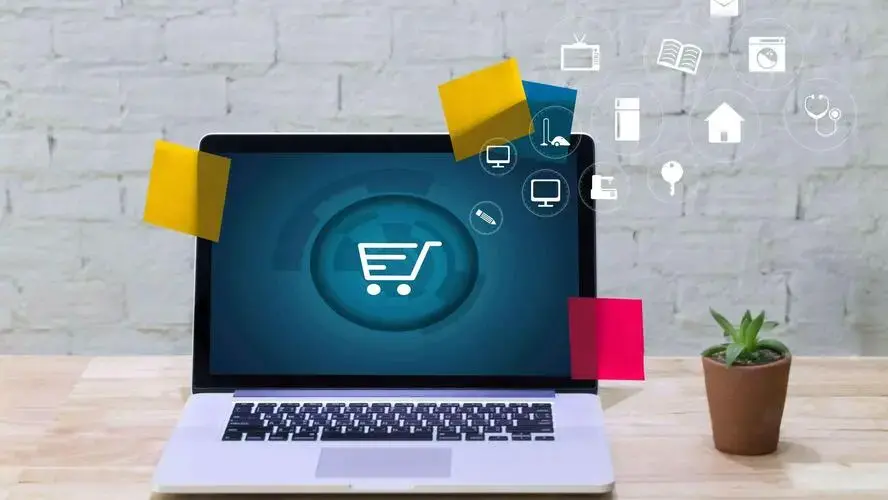eCommerce email marketing can help you grow meaningful relationships with your customers. But, in order to succeed, you need a solid, well-thought-out strategy that makes use of proven best practices to help you convert more customers.
With that in mind, here are 8 eCommerce email marketing best practices and examples that convert.
1. Welcome Email
Email marketing allows you to reach your audience and promote your eCommerce products right in their inboxes. This strategy hinges on your ability to build trust and loyalty with your subscribers. That's why the first tactic you need to focus on is building trust.
For this, you'll need to create a welcome email series that makes a lasting impression on your recipients.
When subscribers share their contact details with you, it obviously means they expect to hear from you. So make sure you reach out by sending an email series to welcome them warmly and thank them for subscribing.
Do your best to connect on a personal level with your subscribers in this initial email interaction. Let them know what to expect from you with regard to the type of emails you'll send and the frequency with which you send them. You might consider including the next steps to take to get the most from your product, service, or content.
Here’s an example of a welcome email from Slack:
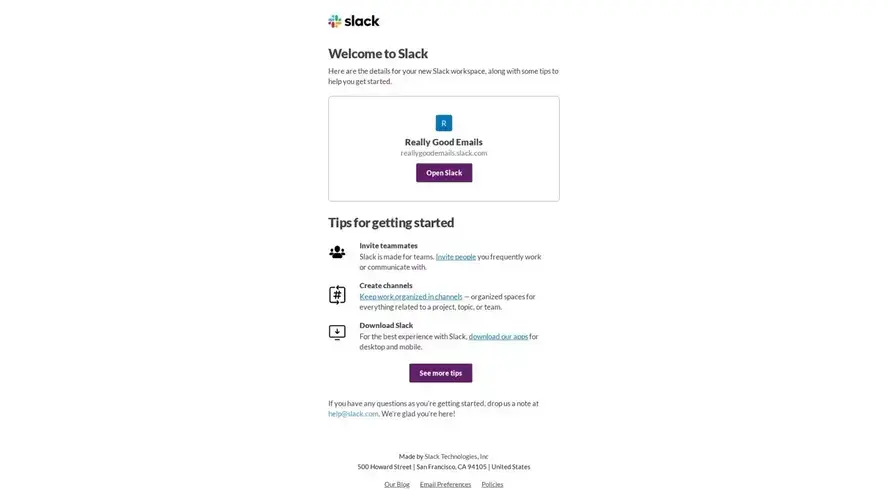
Keep in mind that welcome emails have a much higher open rate than other types of emails. Also, users who are met with welcome emails are 40% more likely to interact with your content, so make full use of this opportunity to set the foundation for a strong relationship with your recipients.
A great way to make a lasting impression and boost your conversions would be to send welcome coupon codes as part of your welcome series.
2. Product Recommendation Email
In addition to sending a welcome series, you should also consider sending out recommendation emails.
Everyone likes receiving great recommendations, and you can prove to your subscribers just how helpful and relevant you are by helping them make better-informed decisions about what products to buy or which services to use.
For this to work effectively, you must have a good understanding of the types of products your subscribers are interested in. You can then include personalized recommendations in your newsletter thereby turning your emails into product endorsements that your subscribers trust.
Barnes & Noble is a great example of a brand that uses product recommendation emails to not only provide readers with great recommendations but also increase conversions and sales.
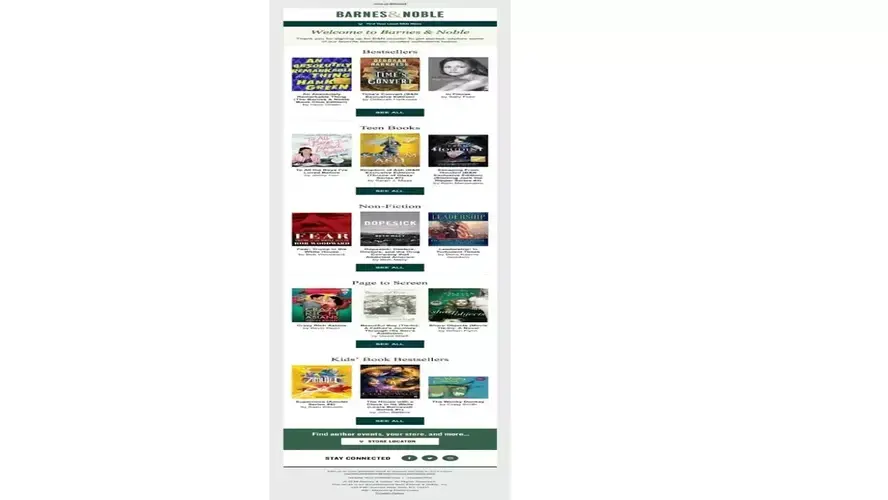
3. Product Promotion Email
Product promotions and new product launches give you an opportunity to send high-converting emails to your audience.
You can even take a leaf out of Adobe's marketing handbook by creating a product promo with two products in comparison.

This type of email allows you to cast your net wider which makes it perfect for targeting two different segments of your customers in the same email. This way, you hit two birds with one stone, so to speak.
The email also has the added benefit of giving you more information about your target customers based on who clicked which product in the email. You can then use the information you gathered to refine and re-target specific customer segments.
4. Abandoned Cart Email
Cart abandonment or remarketing/retargeting emails are a great way to win back lost sales. According to recent statistics from over 41 studies conducted, the average cart abandonment rate is around 70%. This means 7 out of 10 eCommerce customers won’t complete their purchases.
This is a troubling number for any eCommerce store owner, and one way to solve the problem is by sending cart abandonment emails as a way to re-engage the customer and get them to complete the transaction.
In addition to that, you can also send remarketing emails to get them to buy something else within your store. An even better way is to merge the abandoned cart and retargeting emails.
Include the image and description of the abandoned product as well as other related products in your store. This email from ProFlowers is a perfect example of how to put this concept into action:
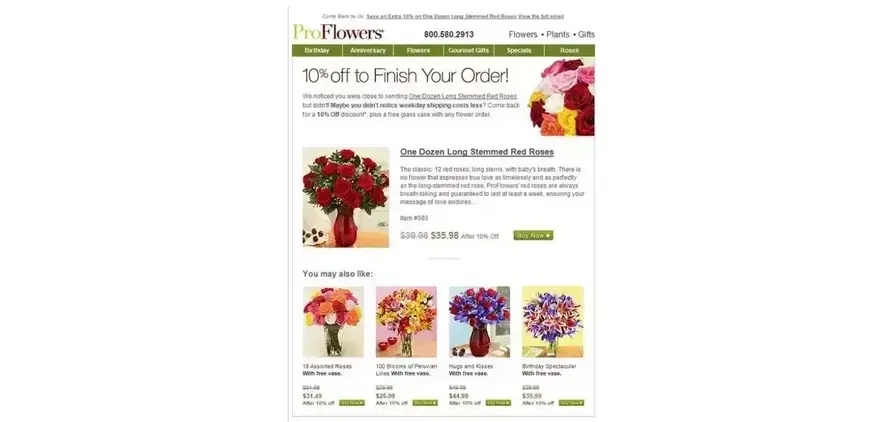
You can use the subscriber’s user data to make more personalized recommendations. Giving them more options to choose from makes it more likely that you’ll be able to get a sale from that email, whether it’s for the abandoned product or something else.
5. Customer Survey Email
It's always good to check in with your customers periodically to see how they are enjoying your product. A lot of brands neglect customer feedback, but this is always at their peril.
Soliciting feedback is actually a very simple process. You can send a simple survey (or even a single question) to your subscribers asking them to share their shopping experience. It's best to send these requests after the customer has received and had ample time to use the product that they ordered.
Here's an example from Dairy Queen which showcases how easy it is to get feedback from customers.
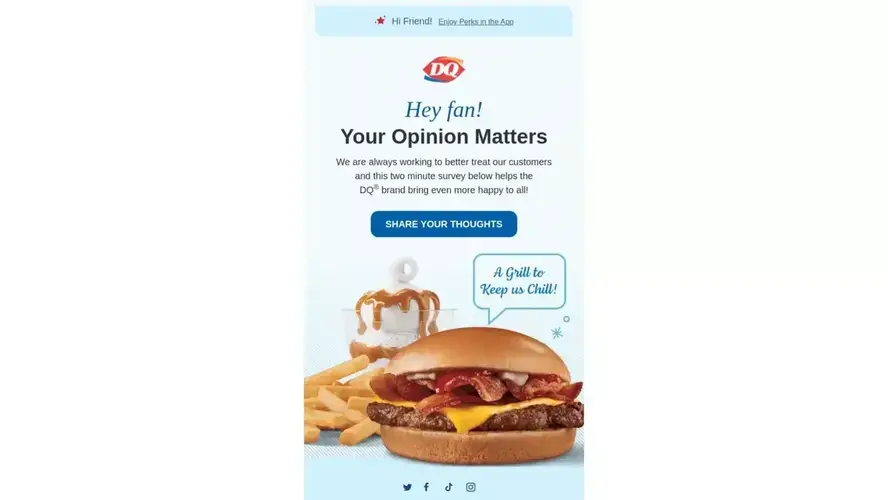
The best email marketing tools allow you to create simple surveys directly within the platform. However, you can easily integrate a third-party survey tool like Survey Monkey to make it easier for you to gather feedback and keep track of all results.
Alternatively, you can include the full survey within the email itself so recipients can simply click reply to give you their feedback.
When you start receiving feedback, you can then use the information to help you improve the experience and enhance satisfaction for future customers.
6. Birthday Gift Email
There's nothing like receiving a free gift on your birthday. For most eCommerce businesses, the use of birthday emails results in higher revenue in comparison with other email campaigns.
This is not surprising at all considering that everyone likes to feel special on their birthday. Sending a birthday email and gift to your customers on that day is a perfect way to personalize your product and make it more likely that customers will make additional purchases.
For this strategy to work, you must set aside a low-cost, high-margin product that you can use for birthdays and other free giveaways. Make sure to ask for your subscriber’s birthday on the sign-up form. Tell them you want the info so you can send them a gift, and it's guaranteed that they’ll input the information.
Here’s an example from Sephora, a popular beauty and skincare brand:
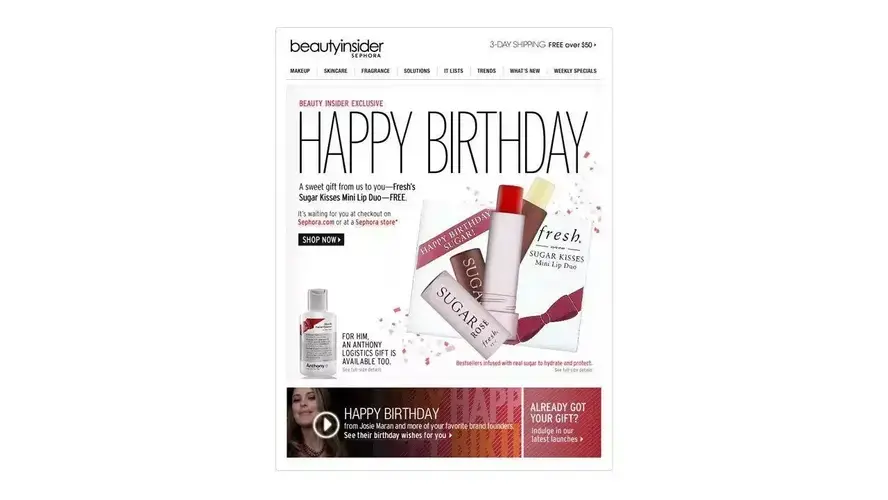
In addition to birthdays, you can also do this with something else exclusive to each customer, such as the anniversary of the day they signed up with you.
7. Product Arrival Email
It's always worth promoting the arrival or launch of a new product in your eCommerce store. This is an effective way to boost revenue and sales.
Creating such an email is easy. Start with a simple image of the new product followed by a header and small text broken into sections.
You can close by offering readers a strong call to action to find out more information. Link to the product page, and that's it. You've effectively put the new product on the market.
8. Sale Notification Email
If your eCommerce store has technology that lets you track your customers' latest activity, then this email is ideal for you to send to your subscribers.
Your information will tell you what your subscribers want, making it easier to send sale notifications whenever the price drops for specific products that they are interested in.
This type of eCommerce email doesn't have to be complex. It can be a simple reminder informing the subscriber of a great deal that they might otherwise have missed. This shows that you are focused on helping them save and you can even the email off with several other product suggestions that they might be potentially interested in.

Conclusion
eCommerce emails can help you attract new customers, retain current customers, boost brand awareness, nurture leads, and win back sales.
But, due to the simplicity with which anyone can create and send out eCommerce email campaigns, it's up to you to ensure that your emails are unique and engaging enough to stand out amongst your competitors' emails in your recipients’ inboxes.
Use the tips outlined in this guide to execute your next email campaign and get recipients to take action, engage with your business, and convert.
There you have it. 8 eCommerce marketing examples that will help you convert more visitors into customers. Do you have other email examples to add? Let us know below!
Frequently Asked Questions
Does my ecommerce store need to be PCI compliant?
Yes, if you’re going to be accepting payments via credit and debit card you’ll need to meet PCI regulations.
Can WordPress be used for eCommerce?
WordPress offers many different ways to build an eCommerce online store for all types of products and markets. Almost 40 percent of all online shops are powered by WooCommerce, a WordPress eCommerce plugin.
Can I run an eCommerce store on VPS and dedicated servers?
Yes, of course. In fact, both types of hosting should be able to handle thousands of transactions per day.
Is shared hosting good for eCommerce?
There are several advantages of using shared hosting for eCommerce, like its low cost, security, and user-friendliness. However, if you’re looking for a scalable hosting plan, managed cloud server might be a better choice for you.

Ron Stefanski is a website entrepreneur and marketing professor who has a passion for helping people create and market their own online business. You can learn more from him by visiting OneHourProfessor.com
View all posts by Ron Stefanski















